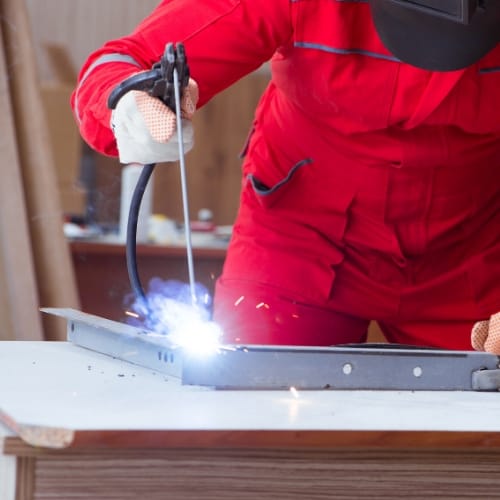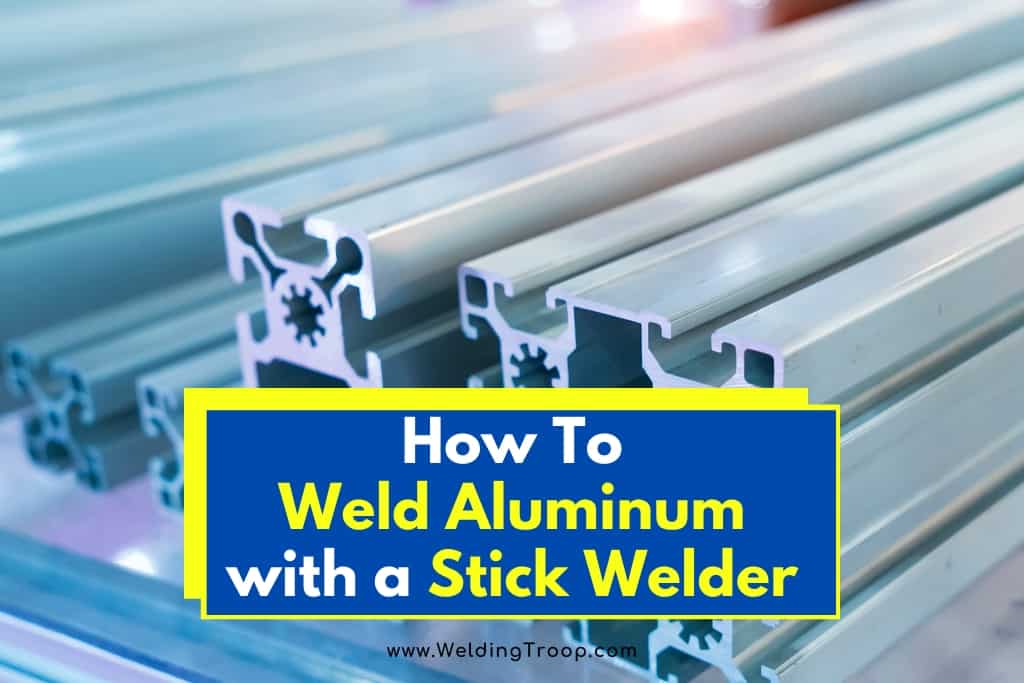Because of how messy and, frankly, ugly the process of welding aluminum with a stick welding can be, many people have simply settled on the idea that it cannot be done. This is far from true, though the practice does take experience, caution, and patience.
Can I weld aluminum with a stick welder? Yes, it is possible to weld aluminum with a stick welder. Since it can be messy, the best methods are:
- AC TIG
- DC TIG
- MIG welding
There are many factors to keep in mind when considering stick welding for an aluminum workpiece. You must consider the thickness of the metal, and know how to prepare the piece for welding, to begin with.
Without the appropriate precautions, you may set yourself up for failure. Below are some of the most pressing details to keep in mind when using the stick welding method.
Table of Contents
Best Stick Welding Methods for Aluminum
The best method for maximum control over the aluminum welding process is AC (alternating current) TIG (tungsten inert gas) using a helium or argon mix. This is the cleanest and slowest technique, ensuring that there is very little mess left behind (making it the perfect candidate for welding thin aluminum, especially).
DC (direct current) TIG welding is acceptable for aluminum workpieces as well.
However, this technique is recommended more for thicker workpieces due to the greater depth of penetration. Use helium gas if you choose to use the DC TIG welding method.
I recently wrote an in-depth article about Stick Welding: Ultimate SMAW Guide, have a look at it.
You do have the option of using argon and flux when using this technique on aluminum, but there’s a slim chance that you’ll have a positive experience with:
- Visibility during the weld.
- Preparation of the welding equipment and workpiece.
- Cleanup of the workspace/workpiece.
Thirdly, there is MIG (metal inert gas) welding. This is significantly faster than TIG, but with some compromises. You will have a reduced extent of control over the process since the base metal will not melt without the addition of a filler metal.
Still, the process will not require either a push-pull or spool gun if the following elements are properly adjusted:
- Weld settings. These settings include:
- Speed of the wire feed
- Flow rate of the gas
- Type or mixture of gases
- Voltage
- Straightness of the MIG cable
- Drive roll tension
It is possible to stick weld aluminum, and, possibly to the surprise of many, it can be done even with a DC stick welder (it works better than you might expect!).

What to Know About Stick Welding Aluminum
The aluminum stick is DCEP (Direct Current Electrode Positive) Reverse Polarity. Before you get started, be aware that, when using the aluminum stick, you will notice that the flux is inclined to spatter.
When beginning to cool, it will adopt a “muck-like” appearance. Don’t be alarmed if this is your first time observing something like this – it is quite normal for this process.
Of course, various types of maintenance alloys will behave differently, and you may not have this experience with the types of sticks you wind up using.
This extent of variation is naturally, due primarily to the flux composition. Still, it’s useful to know the risks and quirks of the process ahead of time.
Fortunately, there are steps you can take to make the process go a bit more smoothly. >> Check the video below
- Before beginning your weld, you can make sure the weld will be a bit cleaner by directly heating the aluminum using a torch with a carburizing flame.
- Note: Intentionally applying this extreme heat builds soot on the surface of the workpiece.
- Switch back to a neutral flame.
- Return the concentrated heat to the aluminum.
- When the soot clears, the workpiece has reached 400֯F.
Preheating in this way will allow the welding to flow more smoothly. You must also keep the following in mind:
- Aluminum dissipates heat up to four times faster than carbon steel.
- Aluminum has an oxide layer which can be removed with a stainless-steel wire brush for the best results.
- Many people use their grinding wheel intended for carbon steel on their aluminum workpieces and expect positive results. Unfortunately, this is not ideal, as it only serves to fold the oxide layer into the metal. This also happens when using a high-speed wire wheel bead brush. The best ways to remove this layer include:
- Filing the metal with light sanding pressure
- Chemical etching
- Hand wire brushes
- Many people use their grinding wheel intended for carbon steel on their aluminum workpieces and expect positive results. Unfortunately, this is not ideal, as it only serves to fold the oxide layer into the metal. This also happens when using a high-speed wire wheel bead brush. The best ways to remove this layer include:
How Stick Welding Works
When welding aluminum, remember that the recommended positioning for working is at an angle point straight toward the desired site (not from an upward, downward, or another angle).
I recently wrote an in-depth article about Stick Welding: Ultimate SMAW Guide, have a look at it.
You also need to perform the weld at a relatively fast travel speed. The weld also calls for a short arc, so bear that at the forefront of your mind when working. Here are a few more key details to know about stick welding:
- What happens during stick welding: When you are stick welding, a current is flowing through the stick onto the workpiece. The workpiece can be considered to be a negative electrode, and the stick, a positive electrode. When the stick is pulled away from the workpiece, that creates an arc. The closer to the workpiece you hold the stick, the shorter the arc will be.
- How the electrode and flux work together: As the stick is consumed throughout the welding process, the metal melts onto the metal. The flux protects the melted metal as the weld progresses, keeping it safe from atmospheric gases.
- How the arc works to weld the pieces together: The arc produced from the electrical connection between the electrode and the workpiece heats up each component, resulting in the electrode metal achieving a plasma-like state. As the molten puddle is pulled along the weld line, the upper and lower plates become sealed together.
This is why stick welding works for aluminum workpieces as well. Though the chemistry works just the same, admittedly, the process is distinct primarily due to its messiness and tendency to yield a non-aesthetically pleasing weld.
(This is also why you must choose electrodes that are specifically made for welding aluminum, otherwise, you may get lackluster results. 4043 Electrode rods are highly recommended.)
The process of stick welding aluminum will generally be quite similar to welding other metals but keep the above factors in mind as you work. Before you start, you’ll need to expose a bit of the electrode just to make the process a little neater.
To do this, you’ll have to scratch the tip of the stick on a hard surface to bear a bit of the electrode (particularly when using an aluminum electrode).
Related Reading: Do You Need a Spool Gun to Weld Aluminum?
What to Keep in Mind About Stick Welding
As you weld, keep the electrode as close to the workpiece as possible without freezing the rod (getting the electrode stuck in the cooling puddle of metal).
To keep this from happening, you must simply float the rod without drifting too close to the workpiece or slowing down too much while welding.
(This is why a fast travel speed is recommended for this type of welding.)
This can take a little while to learn, since stick welding, also known as “Shield Metal Arc Welding,” or SMAW is known.
This second name is a bit more revealing of this learning curve, as it puts the welder in full control of the electrode. Although it is possible to weld aluminum with stick welding, it is certainly not the best option.
Keep the advantages and drawbacks in mind when considering this technique.
| Pros | Cons |
|---|---|
| Stick welding equipment is relatively expensive, although no shielding gas is needed, so this is a financial tradeoff. | Very messy for aluminum workpieces. |
| This technique still works well on painted or rusted metal workpieces. | Flux tends to spatter and requires extensive experience to yield a clean weld. |
| Working conditions are flexible due to the lack of shielding gas. | Difficult to do with thin workpieces |
If you are interested in welding gear or tools, then just follow the link to our recommendation page where you can see all welding accessories we love and use (NO CRAP)
+ Highest Quality
+ Tested & Approved
+ Affordable Machine
+ Right Balance Between Quality & Price


